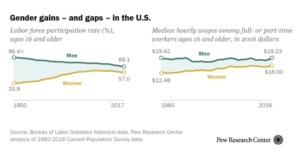Gender Gaps – and Gains – in the U.S.

Originally published by Katherine Schaeffer for Pew Research Center
For American women, job opportunities look much different than they did 50 years ago. Women have made gains in labor force participation and wages, and they’ve increased their presence in the highest-paying jobs. Some of that progress has stalled in recent years, however, and large gender gaps persist at the top levels of government and business leadership.
Ahead of Women’s History Month, here’s a look at some of these trends and data points, based on Pew Research Center surveys and analyses as well as federal data.
Women made up 47% of the U.S. civilian labor force in 2023, up from 30% in 1950 – but growth has stagnated, Bureau of Labor Statistics (BLS) data shows. The share of women in the labor force generally grew throughout the second half of the 20th century but has since leveled off.
The BLS projects that women will continue to make up slightly less than half of the labor force through 2032.
Women outnumber men in the U.S. college-educated workforce, now making up 51% of those ages 25 and older, according to Current Population Survey data from the fourth quarter of 2023. Women first surpassed men in the college-educated labor force in the fourth quarter of 2019. They remained more than half of this group through the COVID-19 pandemic, which resulted in a sharp recession and an overall decline in the size of the nation’s labor force.
The gender shift in the college-educated labor force happened about four decades after women overtook men in the number of adults earning a bachelor’s degree each year.